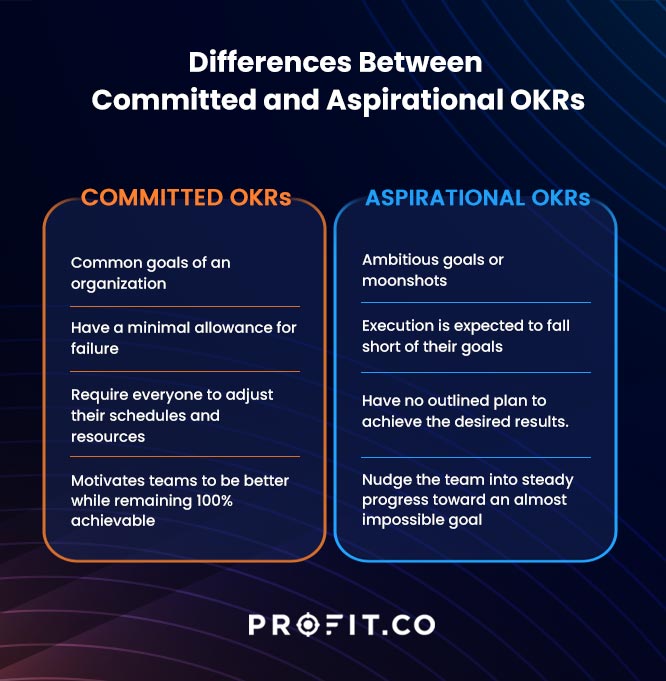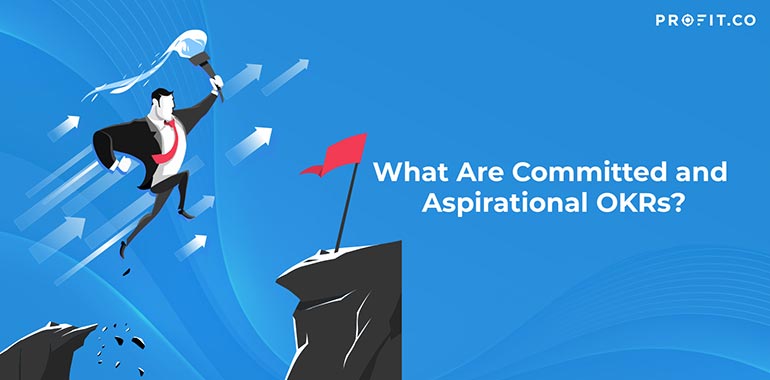In simple terms, the acronym OKR stands for “Objectives and Key Results”. In more detail, an OKR can be defined as a rigorous goal-setting and tracking method invented by Andrew Grove and used in Intel from its early years. Andrew Grove derived the concept of OKR from the teachings of Peter Drucker’s Management by Objectives.
People also know him as the father of OKR methodology. OKRs (Objectives and Key Results) ensure everyone within your organization aligns with the essential priorities.
There are three primary types of OKRs: learning, aspirations, and committed OKRs. For a better understanding, let’s compare the two most common types of OKRs and how to choose the best ones for your organization.
What are Committed OKRs?
Ideally, your team must achieve committed OKRs by 100%. The success of these OKRs is vital to the organization’s or team’s overall success. The results of committed OKRs should motivate you to be better while remaining 100% achievable. Although they involve daily activities, they are also goals of the expected performance level.
They aim to push your company to achieve better results.
What are Aspirational OKRs?
Aspirational OKRs motivate you to redefine success for your company. They set the bar higher, exceeding your team’s capability to achieve particular goals within a given period. It’s okay to fall short of these OKRs so long as there’s reasonable progress.
Definition
Committed goals are the goals your team understands and can dedicate to achieving 100%. Aspirational goals exist to prove a theory or pursue a new opportunity. They are more experimental, innovative, and visionary.
Examples
There’s a subtle difference between aspirational and committed OKRs. Committed OKRs primarily involve internal workflows.
For instance, let’s say you have communication procedures in your company, though the information trickles down slowly or goes missing.
This may indicate it’s time to reevaluate internal processes to enhance the work processes. You can designate committed OKRs this way:
Objective: Enhance internal communication processes
- Key Result 1: 90% of employees filled out a survey about communication
- Key Result 2: Evaluate the survey results and select the top 5 areas to improve
- Key Result 3: Consult 30 employees, and 25 should affirm they noticed a change
Such an OKR is attainable without taking unreasonable risks. However, it still revolves around making the necessary changes to enhance the company.
My motivation for all my companies has been to be involved in something that I thought would have a significant impact on the world.
Aspirational OKR Examples
Aspirational OKRs cover aiming for the skies. The aspects you measure using key results can be similar to committed OKRs, but the difference is in the reach that defines the goal. For instance, committed OKR examples for your sales team might be:
Objective: Improve the Sales in the German Market
- Key Result 1: Close the first five sales involving enterprise customers
- Key Result 2: Complete the sales cycle from lead to close within an average of 27 days
- Key Result 3: Achieve a 15% revenue increase in the first quarter for the German Market
Aspirational OKRs in such a case can be:
Objective: Improve the Sales in the German Market
- Key Result 1: Convince 10 big clients to switch to your product from competitors
- Key Result 2: Complete the sales cycle from leads to close within an average of 15 days
- Key Result 3: Achieve a 20% revenue increase in the first month for the German Market

Committed vs Aspirational OKRs
Aspirational OKRs dwell beyond the scope, so everyone likely expects to fall short after taking significant risks. However, the failure is still positive because it represents a bold attempt to get closer to the overall goals.
Committed OKRs have a minimal allowance for failure. If a team fails to deliver the expected outcomes, they must escalate the matter to management.
Differences between Committed and Aspirational OKRs
When comparing committed vs. aspirational OKRs, the first thing to note is that committed OKRs are common goals your organization outlines. Fulfilling these objectives requires everyone to adjust their schedules and resources.
On the other hand, aspirational OKRs define ambitious goals or moonshots. They manifest how the ideal business situation would be.
As Larry Page, the author of Measure What Matters, emphasizes, if you outline a crazy and ambitious goal and fail to achieve it, you’ll still attain something remarkable.
Aspirational OKRs have no outlined plan to achieve the desired results. You don’t need to know the resources your team requires along the way.
During grading, the expected score for committed OKRs is 1.0. Grades below this mark require a wider adjustment scope for planning and execution. The expected score for aspirational OKRs is 0.7. However, achieving even 70% of the target still makes a big difference.
Advantages and Disadvantages
Aspirational OKRs nudge the team into steady progress toward an almost impossible goal. Instead of following the same outlines, they forge new paths using innovative ideas.
Setting the bar high motivates your team to achieve more and think bigger. Innovative platforms such as Profit.co help you remain on track as you monitor your progress.
For committed OKRs, the desired objectives are clear, and everyone understands how to achieve them. However, your team will not push themselves if they can meet the goals of the committed OKRs.
Significance and Relevance
It’s best to have different OKRs for every quarter. Although the focus remains on improvement, the key results should not stay the same.
The priority focus areas can stay the same, but you can reword the main objective to inspire and nurture new discussions.
And even if your most important focus area stayed the same, it would be best if you also changed the wording of the objective to make it more inspiring and spark new discussions.
Choosing the Type of OKRs
Implementing OKRs requires a change in thinking, practice, and time. Therefore, it’s best to begin by adopting committed OKRs if you’re starting. Setting team OKRs that are attainable will help ease the OKR methodology. Committed OKRs simplify developing new habits across the company since the key results are motivating, attainable and specific.
Once your team familiarizes with the outcomes of committed OKRs, it’s easier to implement aspirational OKRs. When faced with a choice between committed vs. aspirational OKRs, combining both is an excellent way to ensure a results-driven company.
Grading Committed and Aspirational OKRs
An OKRs grade refers to the average of the key result scores. Grading highlights the primary difference between aspirational vs. committed OKRs.
In committed OKRs, the company pre-defines the objectives; success means achieving the results 100%.
With aspirational OKRs, the grading could be more precise because the company doesn’t achieve the objectives 100%. Your team achieving 60% of the aspirational goals is still a success.
Selecting the Right Type of OKRs for Your Organization
While committed OKRs are entirely achievable, aspirational OKRs focus more on new innovative strategies. Aspirational objectives motivate continuous problem-solving and directly link to overall strategic goals.
Aspirational OKRs become more challenging, so your teams need to be creative. You can only succeed if your team is willing to try out new ideas, fail, learn and try again.
If it’s your first time introducing the OKR framework, consider adopting committed OKRs first. Attaining every goal will engage and motivate your team to work towards the rest. However, if you already have an OKR framework, you’ll benefit more from aspirational OKRs.
Balancing Between Committed and Aspirational OKRs
Aspirational and committed OKRs are both to help your organization succeed and thrive. Most people prefer combining both types by assigning particular OKRs in either kind.
Determining whether an OKR is aspirational or committed defines the expected amount of effort from every team member.
You can leverage aspirational OKRs for goals you anticipate will require several OKR cycles. The main objective can remain the same in every cycle, but you can bring forward the key results your team failed to attain.
Once the OKR becomes attainable with time, you can label it as a committed OKR. This will motivate your team to achieve the goal before the end of the cycle.
Profit.co allows you to create tags and sign them to OKRs. You can differentiate the tags as aspirational and committed before attaching them to the appropriate OKRs.
FAQs
- What are Moonshot Goals?
Aspirational OKRs gain popularity as moonshot or 10X goals. Although they are achievable, they aim to motivate your team to think beyond committed OKRs.
- Are Aspirational Goals Achievable?
Yes, they are 100% achievable, but they exist to promote continuous growth and improvement.
- What are Committed OKRs?
Committed OKRs are typical goals your company sets and are 100% achievable on all organizational levels.
Conclusion
The choice between aspirational and committed OKRs depends on your goals and your team. Both have outstanding benefits and downsides but work best when used simultaneously. Monitoring the OKRs to determine your progress toward your goals is essential. Profit.co’s innovative platform makes it easier to track your KPIs and OKRs.
Ready to start your OKR Journey for FREE?
Related Articles
-
15 Toughest questions on OKRs Answers by Ben Lamorte – Series 3
We recently hosted an insightful webinar with Ben Lamorte, a leader in OKR coaching. During the session, we covered everything... Read more
-
10 Toughest Questions on OKRs answers by Ben Lamorte -Series 1
In his Mastering OKRs Webinar, Ben Lamorte walks us through his 3-step Formula for successful OKR implementation. He tackles the... Read more
-
14 Toughest Questions on OKRs answers by Ben Lamorte -Series 2
Welcome back to Series 2 of "14 Toughest Questions on OKRs" with Ben Lamorte, where we address the most pressing... Read more
-
OKR Superpower: Aligning Product and Engineering for Maximum Impact
Product and engineering teams often face a tug-of-war between rapid feature delivery and technical feasibility. Product managers want to move... Read more

